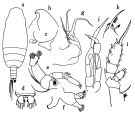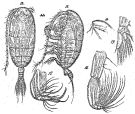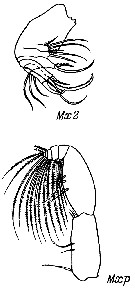|
|
 |
|
Calanoida ( Order ) |
|
|
|
Clausocalanoidea ( Superfamily ) |
|
|
|
Aetideidae ( Family ) |
|
|
|
Chiridiella ( Genus ) |
|
|
| |
Chiridiella brachydactyla Sars, 1907 (F,?M) | |
| | | | | | | Syn.: | no Chiridiella brachydactyla : Grice & Hülsemann, 1965 (p.223, 231, figs.F) | | | | Ref.: | | | Sars, 1907 (p.9, Descr.F); 1925 (p.52, figs.F); ? Tanaka, 1957 a (p.58, Descr.M, figs.M); Markhaseva, 1996 (p.92, figs.F); Chihara & Murano, 1997 (p.683, Pl.33: F); Vives & Shmeleva, 2007 (p.557, Rem.F,M) |  issued from : O. Tanaka in Publ. Seto Mar. Biol. Lab., 1957, VI (1). [p.59, Fig.36]. With doubt. Male: a, habitus (dorsal); b, forehead (lateral); c, last thoracic segment (lateral left side); d, anal segment and furca (dorsal); e, A2; f, Md; g, Mx2; h, distal margin of 1st basal segment of Mxp; i, P2; j, P5. Nota: Head and 1st thoracic segment fused, 4th and 5th fused. Lateral corners of last thoracic segment rounded. Proportional lengths of urosomites and furca 27:21:15:18:6:15 = 100. A1 (24-segmented) exceeds distal margin of furca by terminal 2 segments. 1st basal segment of A2 has a tuft
of hairs. Md: biting part thin-skined. Mx1: outer lobe with 5 long setae, exopod with 10 setae, endopod and inner lobes reduced. Mx2 reduced, 4th and 5th lobes are large, each with a strong spine at the apex. 5th lobe of first basal segment of Mxp has a peculiar spine folked at the apex.
|
 Issued from: G.O. Sars in Résult. Camp. Scient. Prince Albert I, 69, pls.1-127 (1924). [Pl.XVI, figs. 12-17]. Female: 12, habitus (dorsal); 13, idem (lateral left side); 14, forehead (lateral); 15, Mx2; 16, Mxp; 17, P4.
|
 Issued from : E.L. in Proc. Zool; Inst. RAN, 1996, 268. [p.93, Fig.68]. After Sars, 1924. Female: Mx2 and Mxp.
|
 Chiridiella brachydactyla Chiridiella brachydactyla female: 1 - Mx2 with 5 endites. 2 - Mx2 not strongly modified in comparison with typical. Setation first-fifth endites are nearly of the same size, without pincers-like spines. 3 - Endopod of P1 without external lobe. 4 - Exopod of P1 with 1 external spine. 5 - Mx2 first-second endites with 3 setae each.
|
 Chiridiella brachydactyla Chiridiella brachydactyla female ; 1 - Mx2 lobes without spines arranged as pincers. 2 - 4th and 5th lobes of Mx2 with enlarged hooklike spines. 3 - P1 exopod with 1 edge spine. 4 - Mx2 without fan of spinules on lobes 1-4.
| | | | | NZ: | 1 + 1 doubtful | | |
|
Distribution map of Chiridiella brachydactyla by geographical zones
|
| | | | Loc: | | | N Atlant. (Azores), ? Japan (Sagami) | | | | N: | 2 | | | | Lg.: | | | (1) F: 3,5; ? (39) M: 2,36; {F: 3,50; ? M: 2,36} | | | | Rem.: | Bathypelagic. The Sagami's specimen in a vertical haul from 1000-0 m.
This species is only known through a female and a male specimen, described separately and with an amazing geographical distribution pattern. According to Bradford (1971 b, p. 21) the allocation of the male to this species is not evident. This case, however very uncommon, is not unique (cf. Xanthocalanus echinatus). Markhaseva (1996) does not consider the male identity with the female form described by Sars. | | | Last update : 26/07/2018 | |
|
|
 Any use of this site for a publication will be mentioned with the following reference : Any use of this site for a publication will be mentioned with the following reference :
Razouls C., Desreumaux N., Kouwenberg J. and de Bovée F., 2005-2025. - Biodiversity of Marine Planktonic Copepods (morphology, geographical distribution and biological data). Sorbonne University, CNRS. Available at http://copepodes.obs-banyuls.fr/en [Accessed October 30, 2025] © copyright 2005-2025 Sorbonne University, CNRS
|
|
 |
 |






